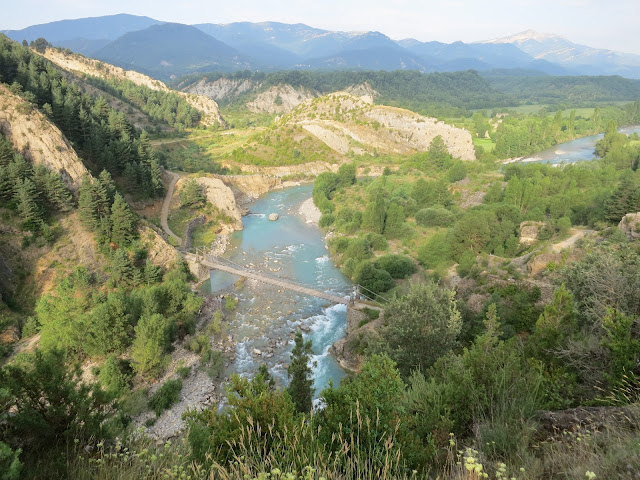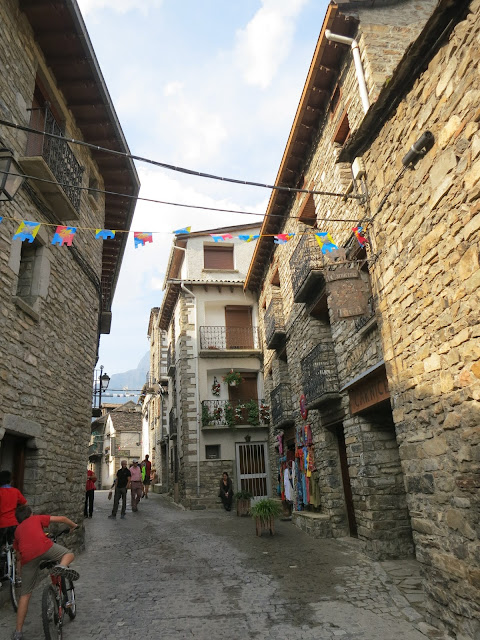Spain has
fourteen national parks and Aigüestortes
is the only one in Catalonia. I have heard so much about this national
park and when we planned our Pyrenees trip I made sure that we would spend some
time here. Its name means ´twisting or winding waters´ and its origin lies in
the fact that within the borders of the national park there are almost 200
lakes, most of them of glacial origin which are fed by many rivers and
waterfalls. The mountain tops are all close to 3000m height. This was enough
for me to know that the scenery will be amazing.
The park has two
gateways, Espot and Boí. Espot seems to be a better choice to access more of
the park but as we came from Ordesa, Boí seemed to be a better choice as it was
closer. We read it somewhere that the village of Taüll is the most
picturesque place to stay therefore that´s where we booked our hotel. It´s only
three miles from Boí.
After an early
start (again!) we drove from Ordesa to Boí. On the map it didn´t seem like a
very long drive but wow! I had never been on such a windy road in my life
before! It was incredible! We had to drove through a narrow gorge, too.
As it was very close to the Pyrenees the view was
amazing. I had my laptop and my book to entertain myself on the way but I
didn´t take any of them out, we didn´t even turn the radio on, just marvelled
at the view. We stopped sometimes to take photos. This was my favourite viewpoint.
This hill looks like a giant picked it up, crushed it from two sides and then
dropped it down again. And the colour of the river is just unbelievable!
The view from Boí over the surrounding areas.
We got to Boí just after 11am and went straight to the tourist information office. The guy behind the counter spoke perfect English and was extremely helpful. They really cater well for tourists of all nationalities. We were given a very good map and he showed us the two most popular walks from the area and some other info on the back about the flora and fauna of the park and even about some cultural aspects. The routes basically lead you from one lake to the other and you can make them as long or as short as you want depending on how many lakes you want to visit. He also gave us the average time it would take to go from one lake to the other. I was very impressed at how easy it all was. We just turned up there with absolutely no idea of what to do and we were out within 10 minutes with a 2 day plan for walking.
We decided
to go and check out the Cavallers reservoir. From here we had the option to
visit four more lakes but we decided that we would take it easy and decide what
to do after every section. We drove up to the dam on the reservoir and
left our little red car in the car park. Behind the car park there was a huge dam, and in front of it the view of the valley.
On the dam.
To the left, the car park far below and to the right the lake. It´s amazing
being in the middle.
And behind
the dam was the Cavallers reservoir. It was huge, clear and the mountains around it
reflected back in the water. It was beautiful.
The path
next to it lead through big rocks. It wasn´t an easy walk and made the going
very slow but it was worth it. The view was beautiful. It´s a great family
walk, too, and seemed to be very popular.
The lake,
looking back from the end.
We had to climb up on a short steep bit.
Behind the
lake lay a great meadow full of grass, rocks and many, many rivers. At some
point five different rivers were flowing around us.
And the
amount of waterfalls! There were three big ones and an uncountable amount of little
ones.
There were
many possible paths but little cairns popped up here and there to show us the
way.
Due to all
the water that surrounded us everything seemed to be moving around us. We had
to pick our way through rivers by hopping from one rock to the other.
The steep
way up ahead of us, the hardest bit of the day.
When we
started the walk there were hardly any clouds on the sky but by this time when we looked back we saw a big grey cloud above the hill that alarmingly started to look like a rain cloud.
We walked to
the end of the meadow and took stock of our situation. Today we didn´t bring
any rain jackets with us as the weather was so clear all morning. Even though
we itched to go and see the other lakes we decided to turn back. And we did
well as within 10 minutes it started raining.
I wasn´t
really worried about getting soaked, I was much more concerned about climbing
through all those slippery wet rocks along the lake. By the time we got back to
the lake however it was really chucking down. We took shelter under some fir
trees. I had a hoody and Paul covered himself with a beach towel. We huddled
together and waited for the rain to go away.
After half
an hour finally the clouds moved on, the rain stopped and we started to slowly
pick our way back to the car park. By the time we got back to the car it was
all sunny again. We decided that it was probably enough for us for the day and drove
to Taüll to find our hotel.





































































